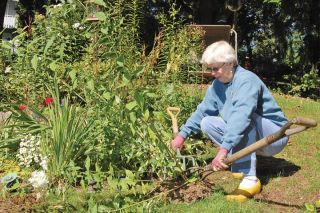September brings the last of the warm weather and the touch of fall. And with the fall comes the many tasks to keep the garden beautiful. This is the time of year for dividing plants, planting bulbs and cutting back the dead and dying flowers of summer.
Dividing plants in the fall lets the subdivisions have a chance to set out roots before the cold days of winter inhibit their growth. Peonies, hostas, phlox, rudbeckias, daylilies, sedum and many other perennials can be teased apart to form new plants. Peonies rarely need to be divided, but if they have been in place for several years and you would like more of the same plant, fall is the time for division. Hostas and daylilies increase in size fairly quickly, so they will need to be pulled apart every three or four years. Phlox and rudbeckia increase in size even more rapidly and will need to be contained every two to three years. Some sedum grow so quickly that you will want to curtail their growth almost on a yearly basis.
So how do you divide plants that need it? The best way to approach is with two garden forks, a pruning saw and maybe even an axe for a very large patch. Dig completely around the clump, lifting the edges as you go. When you can remove the entire clump, take two garden forks back to back and pry the roots apart. If the roots are very tightly interwoven, you may want to take a saw to divide the clump into two or more parts. Hostas and some grasses may actually need the axe to cut the clump apart.
When you have the plant divided into several parts, take a healthy clump to replace where you want it. If you are replanting in the same area, mix a couple of gallon containers full of compost and a little slow release organic fertilizer into the soil before replanting. Plant the clump and water in well. Plant the rest in new areas in your garden or pot up the remainder for friends or plant sales. If left in pots for the winter, bury up to the neck of the container in compost or leaves to protect the roots until spring.
Bulbs are everywhere in nurseries, online or even at box stores, and the varieties are amazing. From daffodils to tulips, from snow drops and crocus to unusual bulbs like Fritillaria and Arisaema, there are bulbs that will produce flowers of infinite variety. The general rule is to plant the bulbs two to three times their diameter, so a one-inch bulb should be planted two to three inches deep while a two-inch bulb should be planted at least four inches deep and will do even better six inches deep. One exception to this is Madonna lilies; they should never be planted deeper than one inch below the surface if you want blossoms. Bulbs truly reflect that old saying, “To plant a garden is to believe in tomorrow.”
General clean-up now and a good weeding will cut down on the weeds next year. There is still time to scatter poppy and cosmos seeds for early bloom next year. The seeds are winter-hardy and will start their growth with the warm days of spring. There are some warm days left, though, so take some time to sit back and enjoy the fruits of your labors. It’s a great time, too, for planning the changes you’ll make next year because there’s always one more new plant you’ve always wanted and maybe a new flower-bed to hold them.
Linda Stephens-Urbaniak can be reached at Lindagardenlady@speakeasy.net.



